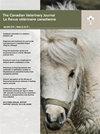红外热成像技术用于检测虐待动物调查过程中的钝器伤。
IF 0.9
4区 农林科学
Q3 VETERINARY SCIENCES
Canadian Veterinary Journal-revue Veterinaire Canadienne
Pub Date : 2024-09-01
引用次数: 0
摘要
由于动物的性情和解剖结构,检测受虐动物身上的瘀伤可能具有挑战性。目视评估结合物理和血清生化评估可能无法检测到损伤。然而,开发和验证一种用于检测家畜瘀伤的无创尸检方法可能具有重要的医疗法律意义。关键临床信息:利用红外线波长的热成像技术可以帮助检测虐待动物案件中没有明显可见伤痕的外伤,从而帮助提供适当的医疗并为法律系统提供指导。本文章由计算机程序翻译,如有差异,请以英文原文为准。
Infrared thermography for detection of blunt-force trauma injuries during animal abuse investigations.
Detection of bruising in living animal victims of abuse can be challenging due to animal temperament and anatomy. Visual assessment, combined with physical and serum biochemical evaluation, can fail to detect injuries. However, development and validation of a noninvasive, antemortem method for detecting bruising in domestic species could have important medicolegal implications. Key clinical message: Thermal imaging utilizing infrared wavelengths can assist in detection of trauma in cases of animal abuse where no visible injuries are apparent, aiding in providing appropriate medical treatment and guidance for the legal system.
求助全文
通过发布文献求助,成功后即可免费获取论文全文。
去求助
来源期刊
CiteScore
1.20
自引率
10.00%
发文量
177
审稿时长
12-24 weeks
期刊介绍:
The Canadian Veterinary Journal (CVJ) provides a forum for the discussion of all matters relevant to the veterinary profession. The mission of the Journal is to educate by informing readers of progress in clinical veterinary medicine, clinical veterinary research, and related fields of endeavor. The key objective of The CVJ is to promote the art and science of veterinary medicine and the betterment of animal health.
A report suggesting that animals have been unnecessarily subjected to adverse, stressful, or harsh conditions or treatments will not be processed for publication. Experimental studies using animals will only be considered for publication if the studies have been approved by an institutional animal care committee, or equivalent, and the guidelines of the Canadian Council on Animal Care, or equivalent, have been followed by the author(s).

 求助内容:
求助内容: 应助结果提醒方式:
应助结果提醒方式:


